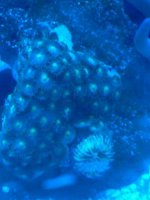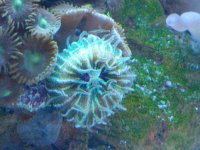- Location
- Staten island
You are using an out of date browser. It may not display this or other websites correctly.
You should upgrade or use an alternative browser.
You should upgrade or use an alternative browser.
Can anybody identify this for me
- Thread starter cosmokramer
- Start date
- Location
- Ronkonkoma, NY
Baby fungia plate
- Location
- staten island
yup thats a plate has a mouth and tenticles and its flat pick up the rock and see if it comes of if it does then its a plate if its grown into the rock then its something else
While I agree its a plate, i disagree with the last part, as I have seen plates that are attached to rocks.yup thats a plate has a mouth and tenticles and its flat pick up the rock and see if it comes of if it does then its a plate if its grown into the rock then its something else
- Location
- Hicksville, NY
Make sure you feed it!
- Location
- staten island
While I agree its a plate, i disagree with the last part, as I have seen plates that are attached to rocks.
plates do not encrust they are a sand dollar family and dwell in the sand they also move along the sand bed unless someone glued it to a rock which would be stupid
- Location
- staten island
you dont have to be sold on it. it is what it is Iam a master diver and see this stuff in the water all the time plates are in the same family as the sand dollar no if and or buts about it they will not attach to anything
Felix, while I don't doubt you are a master diver... but does that also make you a marine biologist?
If so then please explain what a branching heliofungia is?
Now correct me if I am wrong... but sand dollars are in the same family as a starfish, which would make it an invertebrate. So please inform us oh all knowing one >insert sarcasm here<
If so then please explain what a branching heliofungia is?
Now correct me if I am wrong... but sand dollars are in the same family as a starfish, which would make it an invertebrate. So please inform us oh all knowing one >insert sarcasm here<
- Location
- Rego Park, Queens
The problem here is that terminology is getting mixed up. Fungia and Heliofungia are corals, Phylum Cnidaria. Sand dollars are in the Echinoderm phylum, and are related to sea urchins. That said, the life style of a Fungia coral, and its appearance, resembles that of a sand dollar.
- Location
- Huntington
+1 muehlbauer- Sand Dollars are echinoderms and while I respect the fact that you're a master diver the qualification has nothing to do with animal taxonomy.
Plates can also attach to substrate on their own without the aid of adhesives. When they settle as planulae they begin to attach and form their skeleton. It isn't that uncommon to come across pieces of liverock with small plates growing on them.
Plates can also attach to substrate on their own without the aid of adhesives. When they settle as planulae they begin to attach and form their skeleton. It isn't that uncommon to come across pieces of liverock with small plates growing on them.
- Location
- Duluth, Minnesota
Just to clear the air kinda
There area few species of Fungia sp that are colonial, yet others are not. In these species the juveniles attach themselves to" rocks". Once they reach "adulthood" they often detach themselves and become free living individuals.
As e.meuh pointed out, there is taxonomic terminology and what we call descriptive or morphic terminology and they often get confused and there are tons of examples in both the animal and plant worlds. For example, there is a FW-NA fish called a Trout-Perch. It is neither a trout, a perch or a cross but a fish that resembles both of them morphologically. There is also a food often called coral lobster roe. It is neither lobster roe or coral and is actuality a fish roe most of the time. Red like a lobster roe when cooked and a coral like appearance. However, I find the sand dollar family analogy really stretching it.
There area few species of Fungia sp that are colonial, yet others are not. In these species the juveniles attach themselves to" rocks". Once they reach "adulthood" they often detach themselves and become free living individuals.
As e.meuh pointed out, there is taxonomic terminology and what we call descriptive or morphic terminology and they often get confused and there are tons of examples in both the animal and plant worlds. For example, there is a FW-NA fish called a Trout-Perch. It is neither a trout, a perch or a cross but a fish that resembles both of them morphologically. There is also a food often called coral lobster roe. It is neither lobster roe or coral and is actuality a fish roe most of the time. Red like a lobster roe when cooked and a coral like appearance. However, I find the sand dollar family analogy really stretching it.
Last edited:








